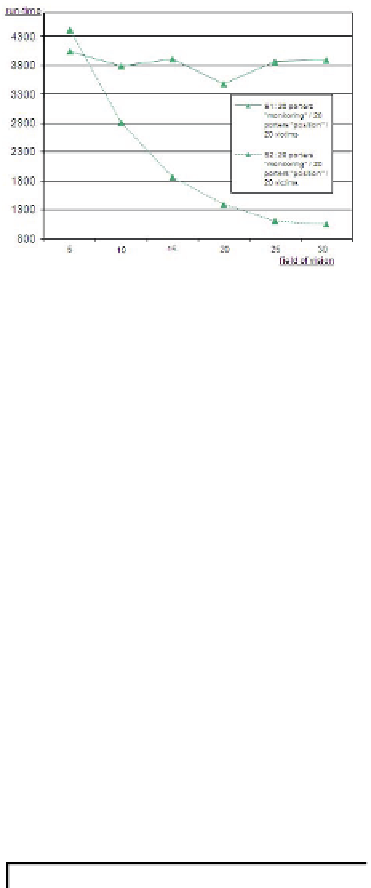Information Technology Reference
In-Depth Information
Fig. 2.
Simulation run-time with the strategies
S
1
and
S
2
for the third group
Communication.
In the following experimentation, we compare the use of broadcast
and the use of the environment for the communication. In these tests, only the commu-
nication filters
f
recept
and
f
accept
of the scenario
S
4
are evaluated and compared to the
broadcast. We call
Broadcast
the experimentation with a matching process executed
by the agents,
Environment
the experimentation with a matching process executed by
the environment.
The agents send “request” messages. The agents interested in these messages are
those which are close to the sender and have a different skill, if the victim can be moved.
In
Broadcast
, the message is broadcasted to all the agents, while in
Environment
they are managed by
f
recept
. Those agents answer with either an accept or a reject mes-
sage through an addressed message. In
Broadcast
, the message is sent to the agent via
point-to-point communication, while in
Environment
, they are managed by
f
accept
.
Each data is an average on 50 simulations. Each simulation is composed of 2000
steps. We have run two series of simulations characterized by two parameters: number
of agents and number of updates during the simulation.
Firstly, we have tried to use the RETE algorithm to implement the communication
filter, and compared it to the broadcast and addressed messaging capabilities of MadKit.
The following table sums up the simulation run-time in function of the messaging im-
plementation: EASI with a RETE tree, MadKit Messaging support,
ad hoc
Environment
and Broadcast.
Agent RETE Madkit Environment Broadcast
10 4624
1096
125
173
20 15215 4050
394
596
50 83785 26306
2377
4755
These results show that the cost of a RETE tree offsets the gains in the message
treatment. This discrepancy with the previous results for activation can be explained by
the cost of the addition and removal of the messages. In the activation part, the entities
are the same all along the simulation, and only rule firing and description modifications
take place.
This has lead us to use an
ad hoc
implementation of the environment for communi-
cation, which treats the calculations in the same way as described in section 4. How-
ever, the comparative results show that the MadKit implementation of the broadcast

























